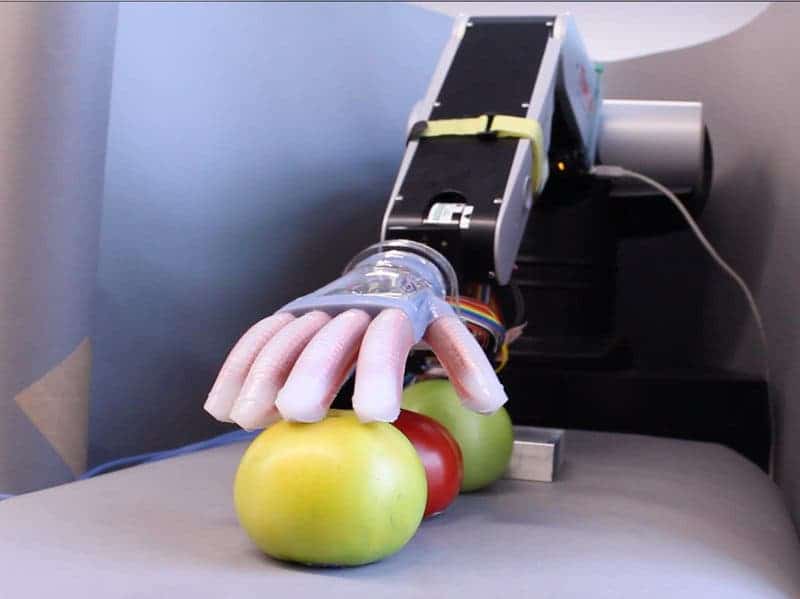
The artificial hand made at Cornell University was able to tell apart tomatoes by their softness and find the ripest one. Credit: Cornell University.
A new kind of robotic arm based on stretchable optical waveguides boasts unprecedented pressure and texture sensing. Modeled on the human arm, the prosthesis has sensors embedded inside it allowing it to ‘feel’ whether a fruit is ripe or more pressure can be exerted, for instance.
“Most robots today have sensors on the outside of the body that detect things from the surface,” said Cornell doctoral student Huichan Zhao. “Our sensors are integrated within the body, so they can actually detect forces being transmitted through the thickness of the robot, a lot like we and all organisms do when we feel pain, for example.”
Elastomeric optical waveguides are tubes packed inside with LEDs and photosensors. Using a combination of soft lithography and 3-D printing, Zhao and colleagues made the core through which light propagates and the cladding which houses the LED and the photodiode.
The fabrication method had been previously used by Cornell researchers to make all sorts of soft and malleable artificial body parts that resembled tentacles and even a squishy robo-octopus. The four fingers and the thumb are pneumatically actuated and mounted on a 3D-printed rigid palm.
As the elastomeric tubes get bent, the light’s intensity shone by the LEDs and measured by the photodiode can increase or decrease. It’s this variable loss of light intensity that allows the prosthesis to sense its environment.
Most robotic prostheses are very rigid, held together with nuts and bolts, and sense their surroundings with sensors that conduct electrical signals. Now, a whole new range of possibilities is opened to science because we can use light just as well and soft robotics closely mimics human hands. Such machines can stretch, twist, scrunch and squish, change shape or size, wrap around objects and perform tasks impossible by rigid robotics standards. In fact, it seems there’s a soft robotics revolution just waiting to happen.
“If no light was lost when we bend the prosthesis, we wouldn’t get any information about the state of the sensor,” said lead author Robert Shepherd, assistant professor of mechanical and aerospace engineering. “The amount of loss is dependent on how it’s bent.”
The prosthesis was put to the test with various tasks. In one experiment, the soft arm was able to scan three tomatoes and determine, by softness, which was the ripest.
Shepherd says the artificial soft arm could be made for as little as $50 (batteries and compressor tank not included).
The next step is to have the prosthesis interface with the brain so that a human can control it solely with thoughts. Elsewhere, in manufacturing plants or automated environments, this robot hand could handle special assembly lines or assist humans with its soft touch.
The findings were reported in the journal Science Robotics.










